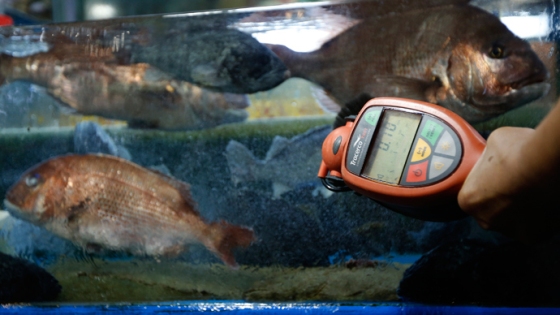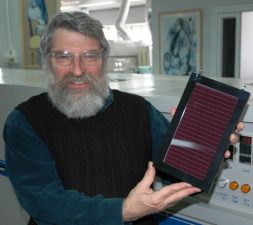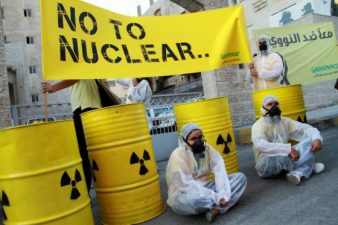 Do you like to eat imported sea fish, especially those like supposedly banned Bluefin tuna? Following the March 2011 Fukushima nuclear plant meltdown disaster, many fish caught in Pacific Ocean waters near Japan’s most well known nuclear power plant have been found to contain abnormally high amounts of radiation.
Do you like to eat imported sea fish, especially those like supposedly banned Bluefin tuna? Following the March 2011 Fukushima nuclear plant meltdown disaster, many fish caught in Pacific Ocean waters near Japan’s most well known nuclear power plant have been found to contain abnormally high amounts of radiation.
The 2011 Fukushima nuclear reactor meltdown occurred as a result of a massive tsunami tidal wave that was the aftermath of a powerful 9.0 magnitude earthquake off the east coast of Honshu, Japan. The damage caused to the nearby Fukishima nuclear power plant was so massive that anti-nuclear activist Dr. Helen Caldicott later referred to it as “much worse than Chernobyl“.
In the nearly three years since this terrible event, substantial amounts of radiation have continued to leak from the plant into the Pacific Ocean; resulting in serious danger to marine life.
Japan’s fishing industry exports more than $13 million USD worth of fish products annually to Canada alone. Fish caught in waters off Japan have obviously been affected by the Fukushima radiation leakage, especially Caesium – 137, one of the most common radioactive substances produced by nuclear reactors.
Due to its high water solubility Ceasium – 137 is now being found in disturbing quantities in many forms of Pacific ocean marine life; ranging from algae and plankton to many species of fish that wind up on consumer dinner tables.
Radioactive Caesium is said to cause various types of cancers; as well as infertility and birth defects.
In a report published in the Canadian newspaper The Vancouver Sun, the following information regarding levels of Caesium or Cesium was revealed by Nicholas Fisher, a marine sciences professor at the State University of New York at Stony Brook:
“In November (2013), the average Japanese catch had 111 becquerels of cesium per kilogram -above the new radiation ceiling of 100 becquerels per kilogram that Japan has announced it will implement for food this spring. The November level declined from a peak level of 373 becquerels per kilogram last April.
“But it was an increase from the October average of 78 becquerels per kilogram. Such persistently elevated levels of radiation warrant more monitoring and research.”
Fisher added:. “It’s not something we can easily dismiss. I would probably be hesitant to eat a lot of those fish”.
As we pointed out earlier in this article on radioactive seafood, fish tested that contained abnormally high level levels of radioactive Caesium included anchovies, halibut, mackerel, sardines, cod, shark, and monk fish.
Seaweed, the material sushi wrapping is usually made of, was found to contain high Caesium – 137 levels in 100% of all specimens tested!
Whether this marine borne radioactivity reaches other oceans, including the Indian Ocean and the Arabian Gulf, has not been determined.
Gordon Edwards, president of the Canadian Coalition for Nuclear Responsibility, summed up these findings accordingly: “There is no safe level of radiation. Government scientific testing authorities should be making every effort to monitor food.”
Read more on the Fukushima nuclear disaster:
Ocean’s Garbage Patches Cleanup Tackled by Teen Boyan Slat
An Energy Insider for Nuclear Newcomers in the Middle East
Dr Helen Caldicott: Fukushima Nuclear Meltdown Much Worse Than Chernobyl
Japan Nuclear Meltdown Will Seriously Affect World Environment
Photo of testing fish for radiation by Reuters/Kim Hong-Ji




To understand just how serious a threat the Fukushima radiation may be, read the following link dealing with the radiation from the disabled nuclear plant now reaching the shores of western North America:
http://www.naturalnews.com/043585_Fukushima_radiation_Pacific_Ocean_marine_science_organization.html
Radioactive water leaking at Fukushima
Jan. 19, 2014 NHK (Japan Broadcasting Corporation)
Tokyo Electric discovered the water flow on the 1st floor of the number 3 reactor building on Saturday.
The stream is about 30 centimeters wide and continuously pours into a drain.
An investigation showed the water contains nearly as high a level of radioactive materials as the contaminated water accumulating in the number 3 reactor building’s basement.
Tokyo Electric detected 24 million becquerels per liter of beta ray-emitting radioactive substances, including strontium, as well as 1.7 million becquerels per liter of Cesium 137.
Tokyo Electric suspects the water for cooling melted fuel in the containment vessel is leaking for some unknown reason.